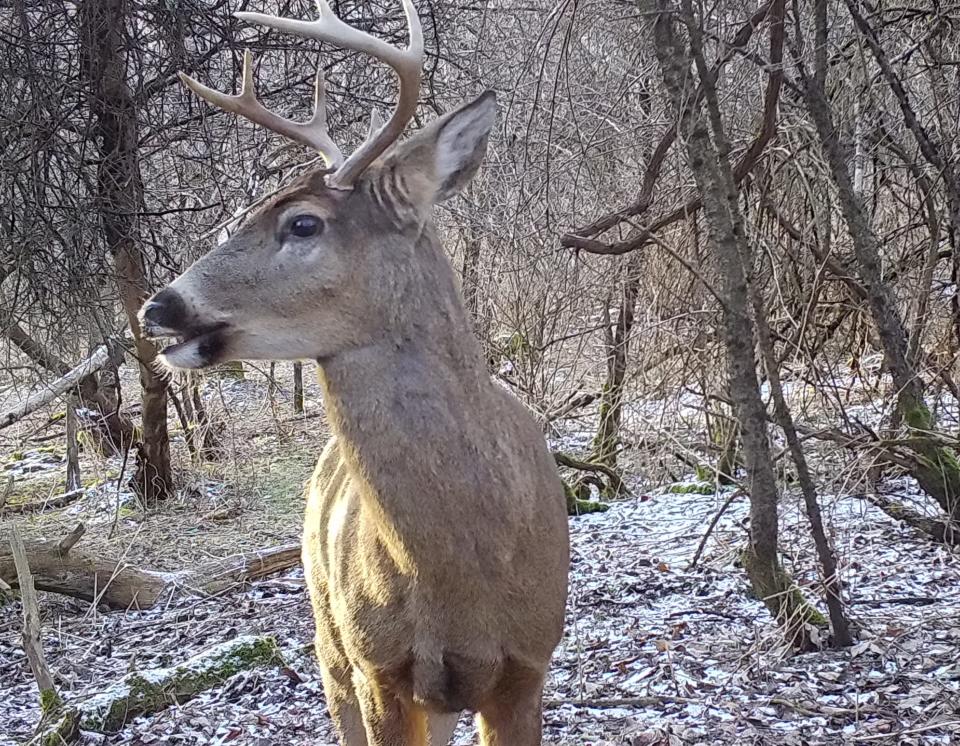The exact timing of the whitetail deer antler drop is still a mystery
"Bucks dropping their antlers already."
It’s becoming a common refrain in the late-season deer camp.
And it’s true.
Each year whitetail antler “drops” or “sheds” are picked up during deer season. And once in a while, a hunter shoots a doe, only to find out that upon inspection, it’s a buck.
Why is that?
Well, deer researchers have studied the annual phenomenon and come up with some reasons.
It seems the consensus today is that the reason that bucks drop their antlers is partially due to their changing hormones and pheromones.
And their priming hormone generation is especially stimulated by ovulating doe.
Bucks with higher testosterone and other pheromones are said to keep their antlers into spring, even March and early April in the Northeast and Midwest, because doe are continuing to have an estrus cycle.

It’s rare, but some doe will cycle into the spring. And of course that is why once in a while we see little spotted fawns during deer season.
That’s the proof.
The one constant is the gestation period of deer. Whitetails will drop their fawns in 200 days (give or take) after conception.
So if a doe is bred in late October around Halloween, that fawn will hit the ground in the middle of May.
Of course when speaking about animals and behavior, we have to realize that they are individuals and that exceptions always occur in a population.
So, some bucks will drop their antlers very early during deer season, even with lots of doe and other bucks rutting, because that buck is just not “feeling it.”
Or the deer could be sick, malnourished, recovering from and old injury, or even be socially intimidated.
Same with doe, they are individuals too. Even deer breeders remark that some doe, when artificially bred, sometimes “don’t take.” And in the wild, some doe are barren, and don’t produce fawns every year.
At first glance, one would think that it is beneficial for a buck to lose its antlers early.
That way hunters wouldn’t be able to target the deer as a buck.
True. But antlerless bucks are often seen as “big doe” and legally punched on DMU (used to be called doe) tags. So it isn’t such a fortuitous occurrence for bucks after all.
Outdoors:A second rut brings a second chance for deer hunters
Changing menu:How whitetail deer browse for their dinner during the winter

In mid-February this year, on one hunting property where I have trail cameras, there are a lot of bucks still carrying their antlers.
And yet on another property, a few miles away, the bucks there seem to have dropped their antlers en masse.
Typically, in December as the deer seasons winds down, more and more bucks show up with the telltale quarter or fifty-cent sized ring on their head where just days or weeks before, a bone-white antler had been carried.
This year, we had a so-called “normal” November rut, then another rut peak of chasing in early December.
So it would be expected that overall, bucks would be carrying their antlers a bit longer than when we have an early rut … in late October.
When we do experience a late October rut, rutting activity winds down quicker and we can expect an earlier overall antler drop.
During the rut, many bucks will run almost day and night seeking the fairer sex, fighting other rivals, and eating and resting little.
Of course all bucks are not the same, and there are some that don’t participate or get caught up in all the fanfare of the whitetail breeding cycle. Whitetail wallflowers.
Others run, fight, and lose a significant percent of their overall body weight (over 25%) in their all-in response to the breeding season.
Antler growth can be very tough on a buck’s health.
Of course a young spike or four-pointer with small antlers is not inordinately debilitated by the growth of his tiny headgear.
But take a big-racked buck, somewhere in the 130-class and up. The growth of large antlers in just a couple months creates a tremendous strain on their skeletal system.
An antler is made of bone. The minerals and elements such as calcium (CA), potassium (K), zinc (Zn), iron (Fe), magnesium (Mg) and especially manganese (Mn) that are the literal building blocks of a big set of antlers have to come from somewhere. And our leached out natural upland woodlands contain a dearth of minerals. Only heavily amended farmers’ fields and mineral blocks put out for livestock offer whitetails an adequate amount of minerals and elements.
It is currently illegal in most places in New York State to supply whitetails with mineral supplements. The DEC’s rationale for the ban is based on a fear of CWD (Chronic Wasting Disease.) Accordingly, minerals blocks put out for whitetails concentrate deer and disease can be spread at these feeding sites greater than would normally happen in any local whitetail population.
Whitetail bucks undergo a type of osteoporosis (bone loss) in the summer months as they grow their antlers.
Osteoporosis is defined as a diminishing of the density of the bone. Whitetails bucks actually rob and steal from their own bones (mostly in the sternum) to grow their antlers because the necessary minerals and elements can’t be found in the woods and processed quickly enough to grow a big set of antlers.
Medical researchers are currently studying antler genesis in deer and other cervids in hope of finding answers to help people suffering from osteoporosis, the debilitating disease.
— Oak Duke writes a weekly column appearing on the Outdoors page of The Spectator.
This article originally appeared on The Evening Tribune: Whitetail buck antler drop timing is still a mystery

